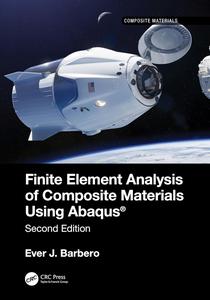
Free Download Finite Element Analysis of Composite Materials Using Abaqus®: Second Edition
by Ever J. Barbero
English | 2024 | ISBN: 0367621452 | 572 pages | True PDF | 41.91 MB
Developed from the author's course on advanced mechanics of composite materials, Finite Element Analysis of Composite Materials with Abaqus® shows how powerful finite element tools tackle practical problems in the structural analysis of composites. This Second Edition includes two new chapters on "Fatigue" and "Abaqus Programmable Features" as well as a major update of chapter 10 "Delaminations" and significant updates throughout the remaining chapters. Furthermore, it updates all examples, sample code, and problems to Abaqus 2020.
Unlike other texts, this one takes theory to a hands-on level by actually solving problems. It explains the concepts involved in the detailed analysis of composites, the mechanics needed to translate those concepts into a mathematical representation of the physical reality, and the solution of the resulting boundary value problems using Abaqus. The reader can follow a process to recreate every example using Abaqus graphical user interface (CAE) by following step-by-step directions in the form of pseudo-code or watching the solutions on YouTube.
The first seven chapters provide material ideal for a one-semester course. Along with offering an introduction to finite element analysis for readers without prior knowledge of the finite element method, these chapters cover the elasticity and strength of laminates, buckling analysis, free edge stresses, computational micromechanics, and viscoelastic models for composites. Emphasizing hereditary phenomena, the book goes on to discuss continuum and discrete damage mechanics as well as delaminations and fatigue. The text also shows readers how to extend the capabilities of Abaqus via "user subroutines" and Python scripting.
Aimed at advanced students and professional engineers, this textbook features 62 fully developed examples interspersed with the theory, 82 end-of-chapter exercises, and 50+ separate pieces of Abaqus pseudo-code that illustrate the solution of example problems. The author's website offers the relevant Abaqus and MATLAB model files available for download, enabling readers to easily reproduce the examples and complete the exercises:
https://barbero.cadec-online.com/feacm-abaqus/index.html